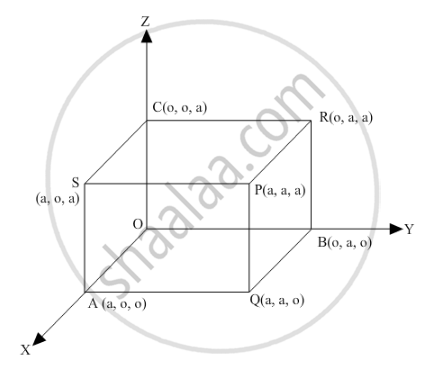Advertisements
Advertisements
प्रश्न
The angle between the two diagonals of a cube is
विकल्प
(a) 30°
(b) 45°
(c) \[\cos^{- 1} \left( \frac{1}{\sqrt{3}} \right)\]
(d) \[\cos^{- 1} \left( \frac{1}{3} \right)\]
उत्तर
\[\cos^{- 1} \left( \frac{1}{3} \right)\]

\[\text { Let a be the length of an edge of the cube and let one corner be at the origin as shown in the figure . Clearly, OP, AR, BS, and CQ are the diagonals of the cube } . \]
\[\text{ Consider the diagonals OP and AR } . \]
\[\text{ Direction ratios of OP and AR are proportional to a - 0, a - 0, a - 0 and 0 - a, a - 0, a - 0, i . e . a, a, a and - a, a, a, respectively } . \]
\[\text { Let } \theta \text{ be the angle between OP and AR . Then,} \]
\[\cos \theta = \frac{a \times - a + a \times a + a \times a}{\sqrt{a^2 + a^2 + a^2}\sqrt{\left( - a \right)^2 + a^2 + a^2}}\]
\[ \Rightarrow \cos \theta = \frac{- a^2 + a^2 + a^2}{\sqrt{3 a^2}\sqrt{3 a^2}}\]
\[ \Rightarrow \cos \theta = \frac{1}{3} \]
\[ \Rightarrow \theta = \cos^{- 1} \left( \frac{1}{3} \right) \]
\[\text{ Similarly, the angles between other pairs of the diagonals are equal to } \cos^{- 1} \left( \frac{1}{3} \right) \text{ as the angle between any two diagonals of a cube is } \cos^{- 1} \left( \frac{1}{3} \right) .\]
APPEARS IN
संबंधित प्रश्न
Find the direction cosines of the line perpendicular to the lines whose direction ratios are -2, 1,-1 and -3, - 4, 1
Direction cosines of the line passing through the points A (- 4, 2, 3) and B (1, 3, -2) are.........
If a line makes angles 90°, 135°, 45° with the X, Y, and Z axes respectively, then its direction cosines are _______.
(A) `0,1/sqrt2,-1/sqrt2`
(B) `0,-1/sqrt2,-1/sqrt2`
(C) `1,1/sqrt2,1/sqrt2`
(D) `0,-1/sqrt2,1/sqrt2`
Find the vector equation of the plane passing through (1, 2, 3) and perpendicular to the plane `vecr.(hati + 2hatj -5hatk) + 9 = 0`
Show that the points (2, 3, 4), (−1, −2, 1), (5, 8, 7) are collinear.
Show that the line through points (4, 7, 8) and (2, 3, 4) is parallel to the line through the points (−1, −2, 1) and (1, 2, 5).
Find the angle between the lines whose direction ratios are proportional to a, b, c and b − c, c − a, a− b.
Find the angle between the lines whose direction cosines are given by the equations
2l − m + 2n = 0 and mn + nl + lm = 0
Define direction cosines of a directed line.
Write the inclination of a line with Z-axis, if its direction ratios are proportional to 0, 1, −1.
Write the coordinates of the projection of the point P (2, −3, 5) on Y-axis.
Find the distance of the point (2, 3, 4) from the x-axis.
If a line has direction ratios proportional to 2, −1, −2, then what are its direction consines?
If a unit vector `vec a` makes an angle \[\frac{\pi}{3} \text{ with } \hat{i} , \frac{\pi}{4} \text{ with } \hat{j}\] and an acute angle θ with \[\hat{ k} \] ,then find the value of θ.
Answer each of the following questions in one word or one sentence or as per exact requirement of the question:
Write the distance of a point P(a, b, c) from x-axis.
A parallelopiped is formed by planes drawn through the points (2, 3, 5) and (5, 9, 7), parallel to the coordinate planes. The length of a diagonal of the parallelopiped is
If a line makes angles α, β, γ, δ with four diagonals of a cube, then cos2 α + cos2 β + cos2γ + cos2 δ is equal to
Find the vector equation of a line passing through the point (2, 3, 2) and parallel to the line `vec("r") = (-2hat"i"+3hat"j") +lambda(2hat"i"-3hat"j"+6hat"k").`Also, find the distance between these two lines.
Verify whether the following ratios are direction cosines of some vector or not
`1/sqrt(2), 1/2, 1/2`
If `1/2, 1/sqrt(2), "a"` are the direction cosines of some vector, then find a
If `vec"a" = 2hat"i" + 3hat"j" - 4hat"k", vec"b" = 3hat"i" - 4hat"j" - 5hat"k"`, and `vec"c" = -3hat"i" + 2hat"j" + 3hat"k"`, find the magnitude and direction cosines of `3vec"a"- 2vec"b"+ 5vec"c"`
If a line makes angles α, β, γ with the positive directions of the coordinate axes, then the value of sin2α + sin2β + sin2γ is ______.
The vector equation of the line passing through the points (3, 5, 4) and (5, 8, 11) is `vec"r" = 3hat"i" + 5hat"j" + 4hat"k" + lambda(2hat"i" + 3hat"j" + 7hat"k")`
If the directions cosines of a line are k,k,k, then ______.
The area of the quadrilateral ABCD, where A(0,4,1), B(2, 3, –1), C(4, 5, 0) and D(2, 6, 2), is equal to ______.
The line `vec"r" = 2hat"i" - 3hat"j" - hat"k" + lambda(hat"i" - hat"j" + 2hat"k")` lies in the plane `vec"r".(3hat"i" + hat"j" - hat"k") + 2` = 0.
What will be the value of 'P' so that the lines `(1 - x)/3 = (7y - 14)/(2P) = (z - 3)/2` and `(7 - 7x)/(3P) = (y - 5)/1 = (6 - z)/5` at right angles.
A line passes through the points (6, –7, –1) and (2, –3, 1). The direction cosines of the line so directed that the angle made by it with positive direction of x-axis is acute, are ______.
Find the coordinates of the foot of the perpendicular drawn from point (5, 7, 3) to the line `(x - 15)/3 = (y - 29)/8 = (z - 5)/-5`.
If a line makes an angle α, β and γ with positive direction of the coordinate axes, then the value of sin2α + sin2β + sin2γ will be ______.
